

“If you were to take a look at the internal organs of a Saint Bernard, a wolf or a Chihuahua, you’d see that they are arranged, shaped, and function in identical ways!” Pet MD
Roger Biduk says “it’s hard to believe that many manufacturers of low-quality pet foods and many vets [especially those who are only qualified to practice basic allopathic veterinary] still say that dogs are omnivores even though their ancestral diet is 49%-56% animal protein, 40%-47% animal fats and only 4%-6% carbohydrates (0% from grains!) which hasn’t changed to this very day… but then again, many of these same lousy vets that are only qualified to practice basic allopathic veterinary sell horrible “prescription diets” [usually Hill’s Prescription Diet] that contain little or NO meat, are very, very, very, very low in animal protein and may contain 60%+ carbohydrates, 900% more than a dog’s natural diet that will eventually cause all sorts of problems, illness and disease… and cha-ching… big $$$$ for the vets”!
On the American Veterinary Medical Association (AVMA) [and now also the AAFP, NASPHV and AAHA] recently telling veterinarians to discourage pet owners from feeding raw pet food diets: “sorry, AVMA, you 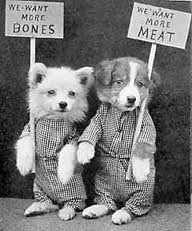 are all wet on this one. My own raw fed dogs have been healthier for the past 20 years than my clients’ dog food eating dogs. Are we veterinarians promoting health or the pet food industry, with all its recalls, Chinese ingredients, and biologically inappropriate diets? And why in the world is AVMA worrying about what perhaps 2.5% of the pet food market does? Surely there are serious problems affecting more pets than this… How about the jerky treats from China that are actually killing dogs, which FDA refuse to order recalled [for the last seven years!].” Dr. Laurie S. Coger, DVM, www.wholisticvet.com
are all wet on this one. My own raw fed dogs have been healthier for the past 20 years than my clients’ dog food eating dogs. Are we veterinarians promoting health or the pet food industry, with all its recalls, Chinese ingredients, and biologically inappropriate diets? And why in the world is AVMA worrying about what perhaps 2.5% of the pet food market does? Surely there are serious problems affecting more pets than this… How about the jerky treats from China that are actually killing dogs, which FDA refuse to order recalled [for the last seven years!].” Dr. Laurie S. Coger, DVM, www.wholisticvet.com
Humans are omnivores; as there is absolutely nothing that a dog has in common with humans, both inside and out it’s utterly absurd, ridiculous and preposterous that anyone would label them the same… and the Smithsonian Institution totally agrees!
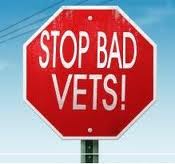 I’ve actually heard (and so have many of you) some vets, so-called “animal nutritionists ” and makers of low-quality pet foods (see comments from Purina below) say that dogs are omnivores, but those are among the 95% of vets (all practicing basic allopathic veterinary) that I wouldn’t let anywhere near my cats/dog.
I’ve actually heard (and so have many of you) some vets, so-called “animal nutritionists ” and makers of low-quality pet foods (see comments from Purina below) say that dogs are omnivores, but those are among the 95% of vets (all practicing basic allopathic veterinary) that I wouldn’t let anywhere near my cats/dog.
I ask them how they can say that dogs are omnivores and they tell me that “dogs have been domesticated and have evolved to eat a starch-based diet”… actually, there’s only three things that has “evolved” in the pet industry:
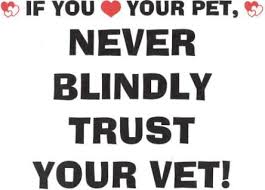 1) Bad veterinarians who:
1) Bad veterinarians who:
-
Sell low-quality “prescription diets”, usually Hill’s Prescription Diets and Hill’s Science Diet or others such as Purina Veterinary Diets, Iams Veterinary Formulas, Eukanuba Veterinary Diets, Royal Canin Veterinary Care Nutrition and Royal Canin Veterinary Therapeutic Formulas
-
Neuter too young!
-
My webpage and social media sites below contain the very best info on vaccinations which includes hundreds of comments and links from dozen of the best veterinarians and vaccine researchers in the world, you’ll know more or just as much on the topic of pet vaccinations as the very best vets:
-
-
-
-
-
Prescribe powerful and often deadly drugs such as steroids [i.e. Prednisone), NSAIDs [Rimadyl (carprofen), Metacam (Meloxicam), Deramaxx (Deracoxib), Previcox (Firocoxib), Etogesic (Etodolac), Zubrin (Tepoxalin), Novocox (Carprofen), Vetprofen (Carprofen), Carprieve (Carprofen), Quellin (Carprofen), Orocam (Meloxicam), Loxicom (Meloxicam), Meloxidyl (Meloxicam)] and antibiotics to name a few like candy and at the drop of a hat!
-
Sell carcinogous, neurotoxic poisonous chemical pesticides for heartworm / fleas / ticks / dewormer in the form of pills, topical applications, collars or injections whose active ingredients are sensitizers and irritants that cause terminal cancer, terminal auto-immune disease, terminal neurological disorders, reproductive and birth defects and terminal liver and  kidney disease in people and animals which may include ProHeart 6, Revolution, Bayer Advantage, Bayer Advantage II, Bayer K9 Advantix II, Hartz UltraGuard Pro, Hartz UltraGuard Plus, Hartz First Defense, Bravecto, Bayer Seresto, Interceptor, Heartgard, Parastar, Parastar Plus, Pentagon, Parastar, Parastar Plus, Johnston’s Veterinary, Heartgard Plus; Tri-Heart Plus, Vectra 3D, Capstar, Sentinel, Frontline, Safe-Guard, Trifexis, NexGard, Comfortis, Zodiac, Prowormer, Nemex 2, Droncit, Drontal Plus, Panacur, Heartgard Chewables, Iverhart Plus, Iverhart, Zimectrin or Advantage Multi among others.
kidney disease in people and animals which may include ProHeart 6, Revolution, Bayer Advantage, Bayer Advantage II, Bayer K9 Advantix II, Hartz UltraGuard Pro, Hartz UltraGuard Plus, Hartz First Defense, Bravecto, Bayer Seresto, Interceptor, Heartgard, Parastar, Parastar Plus, Pentagon, Parastar, Parastar Plus, Johnston’s Veterinary, Heartgard Plus; Tri-Heart Plus, Vectra 3D, Capstar, Sentinel, Frontline, Safe-Guard, Trifexis, NexGard, Comfortis, Zodiac, Prowormer, Nemex 2, Droncit, Drontal Plus, Panacur, Heartgard Chewables, Iverhart Plus, Iverhart, Zimectrin or Advantage Multi among others.
2) Pet food companies (Purina, Hill’s, Pedigree, Royal Canin, Eukanuba, Iams, Ol’ Roy, etc.) making very, very low-quality cat / dog foods with horrible guaranteed analysis that are very, very low in animal protein and loaded with carbohydrates [starches, sugars, grains, corn] soy and by-products along with other ingredients that may be dangerous at best, toxic and poisonous at worst. Visit my webpage Pet Food Brands to Avoid.
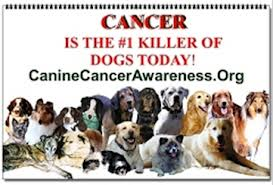 3) The wonderful folks at BigPharmaMafia manufacturing powerful and often deadly prescription drugs such as steroids [e.g. Prednisone], antibiotics, corticosteroids, NSAIDs [Rimadyl, Deramaxx, Metacam, Previcox], vaccines and toxic, poisonous, carcinogenic chemical flea / heartworms pesticides in the form of pills, topical applications and injections that have catapulted cancer as the major cause of death in cats / dogs.
3) The wonderful folks at BigPharmaMafia manufacturing powerful and often deadly prescription drugs such as steroids [e.g. Prednisone], antibiotics, corticosteroids, NSAIDs [Rimadyl, Deramaxx, Metacam, Previcox], vaccines and toxic, poisonous, carcinogenic chemical flea / heartworms pesticides in the form of pills, topical applications and injections that have catapulted cancer as the major cause of death in cats / dogs.
Since the only erroneous reason these people give is dogs have “evolved through domestication to eat a starch-based diet”, I’ll actually give the facts… some of this can also be found on my webpage Grains Are Very, Very Bad For Your Obligate Carnivore Cat And Carnivore Dog.
There is absolutely nothing, nothing, nothing on the inside or outside of a dog that remotely suggests they are anything but carnivores and that hasn’t changed since the age of the dinosaurs.
 The dog family is a group of intelligent, carnivorous mammals that includes domestic dogs and their relatives which include coyotes, wolves, foxes, jackals, dholes, raccoon dogs and bush dogs.
The dog family is a group of intelligent, carnivorous mammals that includes domestic dogs and their relatives which include coyotes, wolves, foxes, jackals, dholes, raccoon dogs and bush dogs.
They’re known scientifically as Canidae, are definitely carnivores and its members are commonly called canids and are members of the order Carnivora.
Carnivore means ‘meat eater’ (Latin carne meaning ‘flesh’ and vorare meaning ‘to devour’) and classifies animals whose diets consist mainly of meat – such as dogs.
One of the simplest ways to know if any animal is a plant or meat eater, look at their teeth and the way they chew.
In addition, cats and dogs have certain defenses that enable them to handle bacteria in a different way than humans do. A shorter digestive track and a more acidic PH in their stomachs create a very, very powerful mechanism of defense against harmful bacteria.
Everything you will read below translates to one very, very simple fact: Everything about a dog and cat’s body design, both inside and out says they are carnivores and obligate carnivores, designed for a carnivorous, hunting lifestyle geared toward killing prey which hasn’t changed one bit in over 40 million years to this very day!
With that in mind, here are six reasons why your dog is totally a carnivore without even one reason to suggest otherwise:
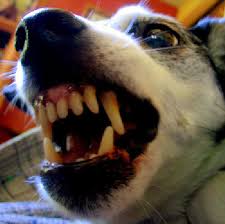 1) Sharp teeth that have been designed for one and only one reason – for biting into, ripping apart and slicing meat, not for grinding grains, corn, vegetables, fruits, soy, kibble or plants! Mother Nature has made teeth highly specialized for each animal on the planet and are structured specifically for the diet each animal eats.
1) Sharp teeth that have been designed for one and only one reason – for biting into, ripping apart and slicing meat, not for grinding grains, corn, vegetables, fruits, soy, kibble or plants! Mother Nature has made teeth highly specialized for each animal on the planet and are structured specifically for the diet each animal eats.
Going back 40 million years to the dinosaurs to tens of thousands of years to the sabre-toothed tiger to today, carnivores (dogs) and obligate carnivores (cats) still have elongated front teeth designed for tearing and killing prey. Their molars are still triangular with jagged edges that function like serrated-edged blades that give a smooth cutting motion like the blades on a pair of shears.
These teeth are totally useless for chewing grains, kibble and vegetables but perfectly made for biting into, ripping, slicing and swallowing meat.
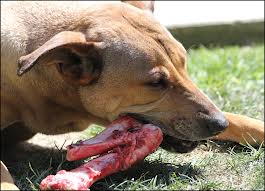 Cats and dogs can’t chew (omnvivores and herbivores chew), they chop their food. Like all carnivores going back to the tyrannosaurus rex and the great white shark, the jaws of dogs and cats operate vertically, unlike herbivores and omnivores that grind their food by side to side chewing, to provide a smooth cutting motion and open widely to swallow large chunks of meat.
Cats and dogs can’t chew (omnvivores and herbivores chew), they chop their food. Like all carnivores going back to the tyrannosaurus rex and the great white shark, the jaws of dogs and cats operate vertically, unlike herbivores and omnivores that grind their food by side to side chewing, to provide a smooth cutting motion and open widely to swallow large chunks of meat.
It’s the perfect combination for cutting meat into smaller chunks and the absolute worst for chewing grains, vegetables, corn and kibble.
Herbivores (cows) and humans (omnivores) on the other hand chew from side-to-side. They have broad, flat back teeth that are ideal for grinding grains and plant material into finer particles. That’s why a cow “chews its cud”.
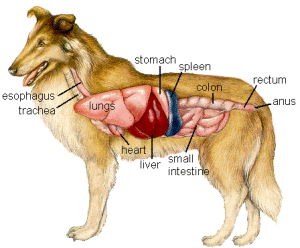 2) The digestive anatomy of carnivores (dogs) and obligate carnivores (cats) are totally different than those of herbivores and omnivores.
2) The digestive anatomy of carnivores (dogs) and obligate carnivores (cats) are totally different than those of herbivores and omnivores.
Because meat is easily digested while plants and grains are very hard to digest, the small intestines of carnivores are very short. Carnivores and obligate carnivores have a very short digestive system with food staying in a cat for only five to seven hours and seven to ten hours in a dog.
Plant and vegetable matter such as grains, corn, soy, wheat, etc. (all not fit for human consumption and found in low-quality pet foods sold in grocery stores and vet clinics; i.e. Hill’s Prescription Diets) can take 3-5 days to be processed in a herbivore’s gut… now you can see 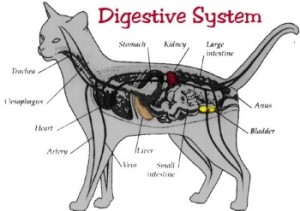 the huge health problems that occur when carnivores (dogs) and obligate carnivores (cats) are fed commercial pet foods containing these horrible ingredients… too bad that so many vets that only practice allopathic veterinary don’t understand this… or is it more “calculated” and they do?… unbelievable…!
the huge health problems that occur when carnivores (dogs) and obligate carnivores (cats) are fed commercial pet foods containing these horrible ingredients… too bad that so many vets that only practice allopathic veterinary don’t understand this… or is it more “calculated” and they do?… unbelievable…!
Herbivores have a gastrointestinal tract that’s unusually long, sometimes exceeding eighteen times the animal’s body length. Longer systems like this are needed for consuming a grain and plant-based diet. Cows, for example have one stomach with three compartments.
 That’s why it’s very, very, very, very, very, very, very important to give cats / dogs a high protein, low starch, low carbohydrate / low sugar calorie-dense diet because they absorb the nutrients so fast.
That’s why it’s very, very, very, very, very, very, very important to give cats / dogs a high protein, low starch, low carbohydrate / low sugar calorie-dense diet because they absorb the nutrients so fast.
High fiber, high carbohydrate (starch, cellulose, sugar) laden foods with grains and corn such as those bought in grocery stores (i.e. Purina, Ol’ Roy, Pedigree, Iams, Royal Canin, Eukanuba, Science Diet) or veterinarian clinics / hospitals [Hill’s Prescription Diets] totally ignore this fact, providing an unnatural burden on the GI tract that results in excessive system bulk and reduced nutrient absorption often resulting in many serious illnesses and diseases leading to premature death.
3) Dogs and cats are built to handle bacterial loads from food that would cause significant illness in you or me. Your pet’s body is well equipped to deal with heavy doses of familiar and strange bacteria because nature built them to catch, kill and immediately consume their prey.
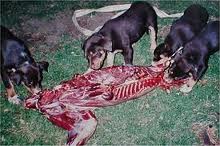
What’s more, carnivores (dogs) and obligate carnivores (cats) exhibit a much higher concentration of stomach acid which allows for faster digestion of animal protein. The stronger acid kills the disease-causing bacteria abundant in decaying meat.
A very high concentration of stomach acid helps quickly break down proteins. Carnivores have a stomach acidity of about pH 1; humans at around pH 5 when there’s food in the stomach.
Many unknowledgeable people and all unethical and / or unknowledgeable veterinarians and their member associations say bacteria and Salmonella are a big danger for cats / dogs… NOTHING, NOTHING, NOTHING could be further from the truth, a vet’s LAST-DITCH effort to scare you into buying a garbage and potentially dangerous bag of Hill’s Prescription Diet!
The pH scale goes from 0 to 14, with 0 representing a HIGHLY, HIGHLY, HIGHLY acidic substance, 7 representing a neutral one and 14 representing a highly alkaline one.
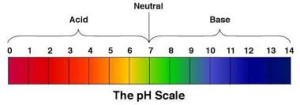 While the pH of human stomach juice can vary quite dramatically depending on what you’ve eaten, it tends to stay around 5 when there’s food in the stomach. The stomach acid of a dog [carnivore] on the other hand, has a pH of around 1.
While the pH of human stomach juice can vary quite dramatically depending on what you’ve eaten, it tends to stay around 5 when there’s food in the stomach. The stomach acid of a dog [carnivore] on the other hand, has a pH of around 1.
Just to highlight how utterly ridiculous and preposterous these scare tactics by bad veterinarians are, the pH scale is logarithmic… which means each whole pH value below 7 is ten times more acidic than the next higher value.
In other words, a cat’s / dog’s stomach acid can be 50X [or is it 10,000X?] more acidic than yours or mine at a given instance… in fact, it’s so acidic that it can dissolve many metals… for further reference, battery acid has a pH of 0.8!
In addition to the acid, dogs and cats also naturally produce a tremendous amount of bile. Bile is both anti-parasitic and anti-pathogenic.

So if something potentially harmful isn’t entirely neutralized by stomach acid, the bile is a secondary defense.
As if a super-high concentration of stomach acid and bile wasn’t enough, your pet’s powerful pancreatic enzymes also help break down and digest meat.
4) Herbivores and omnivores have one very powerful digestive weapon that dogs and cats have a very, very insignificant amount of… salivary amylase.
Salivary amylase is a special enzyme that omnivores and grain and plant-eating animals (and humans) produce in their saliva. Because grains and plant matter are so hard to digest (contrary to what some nutritional “experts” and vets say), it’s a most critical enzyme that catalyses the breakdown of starch into sugars.
 In the saliva, amylase begins the chemical process of digestion needed to initiate the break down of starchy carbohydrates before they enter the stomach.
In the saliva, amylase begins the chemical process of digestion needed to initiate the break down of starchy carbohydrates before they enter the stomach.
Dogs and cats do produce some amylase, but the enzyme is produced much further down the digestive tract, in the small intestine where they use amylase produced in the pancreas where the food is closer to going “out“ rather than coming “in“. This places the burden entirely on the pancreas, forcing it to produce large amounts of amylase to deal with the starch, cellulose and carbohydrates in grains and plant matter.
Without salivary amylase, a carnivore’s (dog’s) and obligate carnivore’s (cat’s) digestion of grains and plant matter is decidedly more difficult, if not somewhat impossible.
 The ultimate effects of feeding your cat / dog low-quality pet foods such as those mentioned above that are low protein / high carbohydrate / high starch & sugar include swings in blood sugar and insulin, insulin resistance and high blood sugar. Eating grains and corn in these low-quality pets foods are responsible for most if not all of the degenerative diseases that pet owners pay lousy allopathic veterinarians thousands of dollars to cure… actually, these vets usually don’t cure anything, they only try to treat the symptoms and most often make matters even worse, for your pet and your wallet… cha-ching!
The ultimate effects of feeding your cat / dog low-quality pet foods such as those mentioned above that are low protein / high carbohydrate / high starch & sugar include swings in blood sugar and insulin, insulin resistance and high blood sugar. Eating grains and corn in these low-quality pets foods are responsible for most if not all of the degenerative diseases that pet owners pay lousy allopathic veterinarians thousands of dollars to cure… actually, these vets usually don’t cure anything, they only try to treat the symptoms and most often make matters even worse, for your pet and your wallet… cha-ching!
5) Carnivore dogs and obligate carnivore cats have no ability to convert ALA (alpha-linolenic acid) to efficient and / or biologically appropriate EPA (eicosapentaenoic acid) or DHA (docosahexaenoic acid) which is why it’s so important to add Omega 3 supplements.
And for those who say that it’s OK to feed a carnivore dog like an omnivore or even a herbivore and get EPA / DHA from plant matter, Dr. Patricia Jordan, DVM, CVA, CTCVH & Herbology, holistic veterinarian, world renowned vaccine researcher and author of “Vaccinosis: The Mark of the Beast” and “Emotions and Biological Harmony in Humans and Pets says it best: “For anyone who thinks algal or marine algae is superior to salmon oil or seafood for you or your canine companion and certainly for the feline companions, think again!”
Carnivores get their EPA & DHA requirements from eating their grass-fed herbivorous prey.
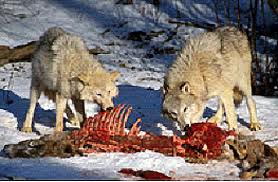 6) Myth – Wolves Digest the Stomach Contents of Their Prey… A Fairy Tale!
6) Myth – Wolves Digest the Stomach Contents of Their Prey… A Fairy Tale!
This myth is repeated over and over and over as evidence that wolves and therefore dogs are omnivores. However, this myth is just that – a myth and it’s totally false. It is not supported by one single shred of evidence!
It’s a documented fact that not only do wolves NOT eat the stomach contents of their prey, they go to considerable lengths to avoid doing so! Only if the prey is small enough (like the size of a rabbit) will they eat the stomach contents, which just happen to get consumed along with the entire animal.
Otherwise, wolves will shake out the stomach contents of their large herbivorous prey before sometimes eating the stomach wall.
In 1958 and for the next 15 years, Dr. Mech was the only full-time wolf researcher in the world.
Dr. Mech is a founding member of the International Union for the Conservation of Nature and Natural Resources (IUCN) Wolf Specialist Group which was instituted to guide wolf recovery and management throughout the wolf’s original range, which was most of the northern hemisphere.
Dr. Mech is also the founder of the International Wolf Center, Ely, Minnesota, a non-profit organization for public education about wolves and wolf recovery with over 10,000 members, 20 employees a 32-p quarterly magazine International Wolf (distribution, 13,000) www.wolf.org/. Their sole purpose is to provide objective, science-based information about wolves.
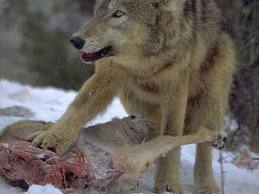 Dr. Mech has been invited to visit and to consult with the governments and/or conservation agencies of Italy, Spain, France, Croatia, Sweden, Israel, and Russia to help them recover, conserve and manage their wolf populations.
Dr. Mech has been invited to visit and to consult with the governments and/or conservation agencies of Italy, Spain, France, Croatia, Sweden, Israel, and Russia to help them recover, conserve and manage their wolf populations.
Dr. Mech has written ten books, over 300 scientific articles and over 100 popular articles about wolves and their prey and wolf management; while his professional experience and published works are too numerous to mention, they can be seen here along with his personal and business website.
The following quotations are taken from Dr. Mech’s 2003 book Wolves: Behavior, Ecology, and Conservation – this book is a compilation of 350 collective years of research, experiments, and careful field observations. These quotes are taken from chapter 4, The Wolf as a Carnivore:
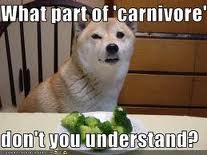 “Wolves usually tear into the body cavity of large prey and…consume the larger internal organs, such as lungs, heart, and liver. The large rumen [which is one of the main stomach chambers in large ruminant herbivores,]… is usually punctured during removal and its contents spilled. The vegetation in the intestinal tract is of no interest to the wolves, but the stomach lining and intestinal wall are consumed, and their contents further strewn about the kill site.” (pg.123). Apparently, the “perplexed nutritionists” at Purina say otherwise, “even wolves in the wild derive nutrition from both plant and animal sources”. See below.
“Wolves usually tear into the body cavity of large prey and…consume the larger internal organs, such as lungs, heart, and liver. The large rumen [which is one of the main stomach chambers in large ruminant herbivores,]… is usually punctured during removal and its contents spilled. The vegetation in the intestinal tract is of no interest to the wolves, but the stomach lining and intestinal wall are consumed, and their contents further strewn about the kill site.” (pg.123). Apparently, the “perplexed nutritionists” at Purina say otherwise, “even wolves in the wild derive nutrition from both plant and animal sources”. See below.
 “To grow and maintain their own bodies, wolves need to ingest all the major parts of their herbivorous prey, except the plants in the digestive system.” (pg.124). Oops, again, the “perplexed nutritionists” at Purina say otherwise, “even wolves in the wild derive nutrition from both plant and animal sources”. See below.
“To grow and maintain their own bodies, wolves need to ingest all the major parts of their herbivorous prey, except the plants in the digestive system.” (pg.124). Oops, again, the “perplexed nutritionists” at Purina say otherwise, “even wolves in the wild derive nutrition from both plant and animal sources”. See below.
This next quote can be found on the Hunting and Meals page at Kerwood Wildlife Education Center:
“The wolf’s diet consists mostly of muscle meat and fatty tissue from various animals. Heart, lung, liver, and other internal organs are eaten. Bones are crushed to get at the marrow, and bone fragments are eaten as well. Even hair and skin are sometimes consumed. The only part consistently ignored is the stomach contents.” Uh-oh, again, the “perplexed nutritionists” at Purina say otherwise, “even wolves in the wild derive nutrition from both plant and animal sources”. See below.
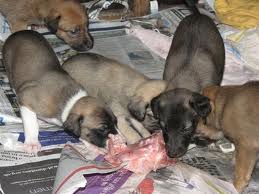
From the mouths of the wolf experts themselves, who have observed countless numbers of kills: Not only do wolves NOT eat the stomach contents of their large prey, they actually go out of their way to AVOID them…!
Additionally, Neville Buck from the Howletts and Port Lympne Zoological Parks in Kent, England, notes that “virtually no small carnivore (which includes varieties of cats, wolves, wild dogs) eat the intestinal contents of their large prey.
“The contents are spilled in the enclosures and are often rolled in by the animals, but very little is eaten (if any is eaten at all)”. His observations can be found in Appendix B of Raw Meaty Bones.
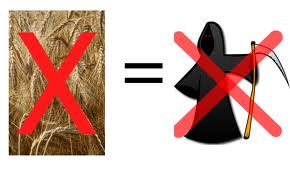
So the next time you hear some “animal nutritionist”, a pet food company who makes low-quality pet foods or some veterinarian who tries to sell you garbage “prescription diets” [usually Hill’s Prescription Diet] say corn, soy and grains are good and raw meat is dangerous to give to your cat or dog, shake your head at their ignorance and quickly walk away – and if it’s a veterinarian, run away… after all, carnivores have only been eating and thriving on raw meat for the last 40 million years or so… and only in the last 50 years getting serious illness and disease leading to premature death because of commercial pet foods full of cheap carbohydrates, starches, sugars (corn & grains) and other ingredients that have been dangerous at best and poisonous at worst!
 Nestlé SA makes some of the lowest quality pet foods available such as Purina, Purina One, Alpo, Beneful, Beneful Healthy Harvest, Busy Bone, Chew-rific, Deli-Cat, Dog Chow, Fancy Feast, Friskies, Gourmet Gold, Mon Petit, HiPro, Kibbles and Chunks, Kit ‘N Kaboodle, Mighty Dog, Purina Pro Plan, TBonz, Purina Veterinary Diets and Whisker Lickin’s.
Nestlé SA makes some of the lowest quality pet foods available such as Purina, Purina One, Alpo, Beneful, Beneful Healthy Harvest, Busy Bone, Chew-rific, Deli-Cat, Dog Chow, Fancy Feast, Friskies, Gourmet Gold, Mon Petit, HiPro, Kibbles and Chunks, Kit ‘N Kaboodle, Mighty Dog, Purina Pro Plan, TBonz, Purina Veterinary Diets and Whisker Lickin’s.
Hard to believe but you can go to the following pages on the Purina website where they say: “Why Corn is Good For My Dog“; “Dogs Are Not Carnivores and “Grains Are Beneficial For Dogs“… OMG!
Purina goes on to say “The belief that dogs shouldn’t eat starches has always perplexed the nutritionists at Purina.
“There is genetic proof that dogs evolved to eat grains.
“Pinpointing the dog’s ability to digest starches is one major breakthrough that has come from comparing the two species”… in all fairness, maybe they’re talking about dogs on Mars or another planet…

The Purina website unbelievably goes on to say “Many people believe dogs are carnivores. In fact, dogs are omnivores, and even wolves in the wild derive nutrition from both plant and animal sources”… shouldn’t one of Purina’s “perplexed nutritionists” tell Dr. Mech that even though he the Senior Research Scientist with the USGS NPWRC and is considered the world’s leading wolf biologist, that according to Purina he’s been totally wrong all these years… oh well…
I guess this also means that the best published paper I’ve ever read on cat / dog nutrition titled “The Biologically Appropriate Food Concept and the Dietary Needs of Cats and Dogs” by Champion Pet Foods, the makers of Orijen, is bogus, according to Purina…
PLEASE, for the health of cats / dogs everywhere, stay away from any and all pet foods made by Nestlé SA, Del Monte, Proctor & Gamble, Colgate Palmolive and Mars… this includes veterinarian recommended and sold “prescription diets”!!!
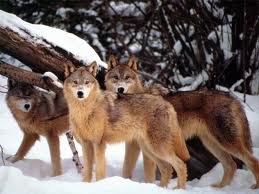 As a faithful companion to humans for some 10,000 years, the trend to humanize our companion dogs comes as no surprise.
As a faithful companion to humans for some 10,000 years, the trend to humanize our companion dogs comes as no surprise.
Yet despite his/her long and close association with humans, the dog remains closest genetically to the Gray wolf, with whom he / she shares 99.8% of his / her mitochondrial DNA.
The close genetic relationship between dog and wolf led the Smithsonian Institution in 1993 to reclassify the dog from its previous separate species designation of Canis familiaris to Canis lupus familiaris.
 In other words, the Timber wolf, the Tundra wolf and your beloved companion dog all fall under the genetic umbrella of the Gray wolf, Canis lupus.
In other words, the Timber wolf, the Tundra wolf and your beloved companion dog all fall under the genetic umbrella of the Gray wolf, Canis lupus.
To answer the question “is my dog a carnivore and a domesticated wolf?”
“You’re damn right he / she is!” says Roger Biduk
Dogs Are Carnivores; Dr. Jeannie Thomason, CVND, CDVN, CSANA
Dogs: The Omnivore-Carnivore Question; Dr. Jeannie Thomason, CVND, CDVN, CSANA & Dr. Kim Bloomer, DVM, CVND, ND, CSAN











 are all wet on this one. My own raw fed dogs have been healthier for the past 20 years than my clients’ dog food eating dogs. Are we veterinarians promoting health or the pet food industry, with all its recalls, Chinese ingredients, and biologically inappropriate diets? And why in the world is AVMA worrying about what perhaps 2.5% of the pet food market does? Surely there are serious problems affecting more pets than this… How about the jerky treats from China that are actually killing dogs, which FDA refuse to order recalled [for the last seven years!].” Dr. Laurie S. Coger, DVM, www.wholisticvet.com
are all wet on this one. My own raw fed dogs have been healthier for the past 20 years than my clients’ dog food eating dogs. Are we veterinarians promoting health or the pet food industry, with all its recalls, Chinese ingredients, and biologically inappropriate diets? And why in the world is AVMA worrying about what perhaps 2.5% of the pet food market does? Surely there are serious problems affecting more pets than this… How about the jerky treats from China that are actually killing dogs, which FDA refuse to order recalled [for the last seven years!].” Dr. Laurie S. Coger, DVM, www.wholisticvet.com I’ve actually heard (and so have many of you) some vets, so-called “animal nutritionists ” and makers of low-quality pet foods (see comments from Purina below) say that dogs are omnivores, but those are among the 95% of vets (all practicing basic allopathic veterinary) that I wouldn’t let anywhere near my cats/dog.
I’ve actually heard (and so have many of you) some vets, so-called “animal nutritionists ” and makers of low-quality pet foods (see comments from Purina below) say that dogs are omnivores, but those are among the 95% of vets (all practicing basic allopathic veterinary) that I wouldn’t let anywhere near my cats/dog. 1) Bad veterinarians who:
1) Bad veterinarians who: kidney disease in people and animals which may include ProHeart 6, Revolution, Bayer Advantage, Bayer Advantage II, Bayer K9 Advantix II, Hartz UltraGuard Pro, Hartz UltraGuard Plus, Hartz First Defense, Bravecto, Bayer Seresto, Interceptor, Heartgard, Parastar, Parastar Plus, Pentagon, Parastar, Parastar Plus, Johnston’s Veterinary, Heartgard Plus; Tri-Heart Plus, Vectra 3D, Capstar, Sentinel, Frontline, Safe-Guard, Trifexis, NexGard, Comfortis, Zodiac, Prowormer, Nemex 2, Droncit, Drontal Plus, Panacur, Heartgard Chewables, Iverhart Plus, Iverhart, Zimectrin or Advantage Multi among others.
kidney disease in people and animals which may include ProHeart 6, Revolution, Bayer Advantage, Bayer Advantage II, Bayer K9 Advantix II, Hartz UltraGuard Pro, Hartz UltraGuard Plus, Hartz First Defense, Bravecto, Bayer Seresto, Interceptor, Heartgard, Parastar, Parastar Plus, Pentagon, Parastar, Parastar Plus, Johnston’s Veterinary, Heartgard Plus; Tri-Heart Plus, Vectra 3D, Capstar, Sentinel, Frontline, Safe-Guard, Trifexis, NexGard, Comfortis, Zodiac, Prowormer, Nemex 2, Droncit, Drontal Plus, Panacur, Heartgard Chewables, Iverhart Plus, Iverhart, Zimectrin or Advantage Multi among others.
 3)
3) The dog family is a group of intelligent, carnivorous mammals that includes domestic dogs and their relatives which include coyotes, wolves, foxes, jackals, dholes, raccoon dogs and bush dogs.
The dog family is a group of intelligent, carnivorous mammals that includes domestic dogs and their relatives which include coyotes, wolves, foxes, jackals, dholes, raccoon dogs and bush dogs. 1) Sharp teeth that have been designed for one and only one reason – for biting into, ripping apart and slicing meat, not for grinding grains, corn, vegetables, fruits, soy, kibble or plants! Mother Nature has made teeth highly specialized for each animal on the planet and are structured specifically for the diet each animal eats.
1) Sharp teeth that have been designed for one and only one reason – for biting into, ripping apart and slicing meat, not for grinding grains, corn, vegetables, fruits, soy, kibble or plants! Mother Nature has made teeth highly specialized for each animal on the planet and are structured specifically for the diet each animal eats. Cats and dogs can’t chew (omnvivores and herbivores chew), they chop their food. Like all carnivores going back to the tyrannosaurus rex and the great white shark, the jaws of dogs and cats operate vertically, unlike herbivores and omnivores that grind their food by side to side chewing, to provide a smooth cutting motion and open widely to swallow large chunks of meat.
Cats and dogs can’t chew (omnvivores and herbivores chew), they chop their food. Like all carnivores going back to the tyrannosaurus rex and the great white shark, the jaws of dogs and cats operate vertically, unlike herbivores and omnivores that grind their food by side to side chewing, to provide a smooth cutting motion and open widely to swallow large chunks of meat.

 That’s why it’s very, very, very, very, very, very, very important to give cats / dogs a high protein, low starch, low carbohydrate / low sugar calorie-dense diet because they absorb the nutrients so fast.
That’s why it’s very, very, very, very, very, very, very important to give cats / dogs a high protein, low starch, low carbohydrate / low sugar calorie-dense diet because they absorb the nutrients so fast.


 In the saliva, amylase begins the chemical process of digestion needed to initiate the break down of starchy carbohydrates before they enter the stomach.
In the saliva, amylase begins the chemical process of digestion needed to initiate the break down of starchy carbohydrates before they enter the stomach. The ultimate effects of feeding your cat / dog low-quality pet foods such as those mentioned above that are low protein / high carbohydrate / high starch & sugar include swings in blood sugar and insulin, insulin resistance and high blood sugar. Eating grains and corn in these low-quality pets foods are responsible for
The ultimate effects of feeding your cat / dog low-quality pet foods such as those mentioned above that are low protein / high carbohydrate / high starch & sugar include swings in blood sugar and insulin, insulin resistance and high blood sugar. Eating grains and corn in these low-quality pets foods are responsible for  6) Myth – Wolves Digest the Stomach Contents of Their Prey… A Fairy Tale!
6) Myth – Wolves Digest the Stomach Contents of Their Prey… A Fairy Tale!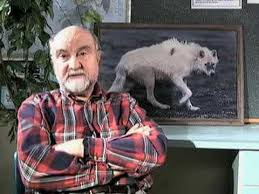
 Dr. Mech has been invited to visit and to consult with the governments and/or conservation agencies of Italy, Spain, France, Croatia, Sweden, Israel, and Russia to help them recover, conserve and manage their wolf populations.
Dr. Mech has been invited to visit and to consult with the governments and/or conservation agencies of Italy, Spain, France, Croatia, Sweden, Israel, and Russia to help them recover, conserve and manage their wolf populations.



 Nestlé SA makes some of the lowest quality pet foods available such as Purina, Purina One, Alpo, Beneful, Beneful Healthy Harvest, Busy Bone, Chew-rific, Deli-Cat, Dog Chow, Fancy Feast, Friskies, Gourmet Gold, Mon Petit, HiPro, Kibbles and Chunks, Kit ‘N Kaboodle, Mighty Dog, Purina Pro Plan, TBonz, Purina Veterinary Diets and Whisker Lickin’s.
Nestlé SA makes some of the lowest quality pet foods available such as Purina, Purina One, Alpo, Beneful, Beneful Healthy Harvest, Busy Bone, Chew-rific, Deli-Cat, Dog Chow, Fancy Feast, Friskies, Gourmet Gold, Mon Petit, HiPro, Kibbles and Chunks, Kit ‘N Kaboodle, Mighty Dog, Purina Pro Plan, TBonz, Purina Veterinary Diets and Whisker Lickin’s.
 As a faithful companion to humans for some 10,000 years, the trend to humanize our companion dogs comes as no surprise.
As a faithful companion to humans for some 10,000 years, the trend to humanize our companion dogs comes as no surprise. In other words, the Timber wolf, the Tundra wolf and your beloved companion dog all fall under the genetic umbrella of the Gray wolf, Canis lupus.
In other words, the Timber wolf, the Tundra wolf and your beloved companion dog all fall under the genetic umbrella of the Gray wolf, Canis lupus.







